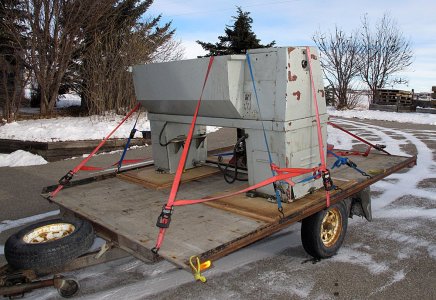JohnW
(John)
I posted the beginning of this story a couple of weeks, ago, but the posting disappeared, so I'll try it again.
The project started a few months ago, so I'll start with a few postings of history before I get into more recent work I've been doing. I have been taking a bunch of pictures along the way, so there will be pictures.
Back in December we were looking for a metal lathe for Protospace. where I am a member. We came across someone who was selling a bunch of gear and long story short, he had a 16x60 sized lathe (7.5HP), a large Bridgeport clone type of mill (5HP, 48" wide table with a power feed) a smaller 14x40 sized lathe (a 5HP Colchester clone), and a big metal band-saw for sale. He had purchased the gear from an auction several years ago and it spend the time in one of his heated garages having never been used.
He was keen to sell it all for a good price, and Protospace was looking for the lathe and a manual mill. We found someone who wanted the big metal band-saw, and I was kind of interested in upgrading my current lathe (a 12x36 2HP unit from House of Tools about 10 years ago).
So we made the deal and headed out with a picker truck for the Protospace gear, and I took my Jeep and one of my trailers to bring home my new toy.

So here we are about 15km east of the city back in December. My new toy is connected to the crane and he is about to put it onto my trailer where I am standing arranging some pieces of scrap plywood to place it on. My trailer can handle the weight as long as it is not too much of a point load. It was probably about 3,000lbs once I removed the chuck, cross-slide vice and tailstock. I originally built the trailer as a snowmobile trailer with a relatively light weight deck, so a bit of re-enforcement seemed like a good idea. The trailer has brakes and a relatively heavy axle and springs since I like the idea of having brakes when hauling stuff on BC highways in the winter.
The other lathe that went to Protospace is sitting there beside my unit. It was loaded onto the truck along with the mill (not visible here), and the big band-saw.
The project started a few months ago, so I'll start with a few postings of history before I get into more recent work I've been doing. I have been taking a bunch of pictures along the way, so there will be pictures.
Back in December we were looking for a metal lathe for Protospace. where I am a member. We came across someone who was selling a bunch of gear and long story short, he had a 16x60 sized lathe (7.5HP), a large Bridgeport clone type of mill (5HP, 48" wide table with a power feed) a smaller 14x40 sized lathe (a 5HP Colchester clone), and a big metal band-saw for sale. He had purchased the gear from an auction several years ago and it spend the time in one of his heated garages having never been used.
He was keen to sell it all for a good price, and Protospace was looking for the lathe and a manual mill. We found someone who wanted the big metal band-saw, and I was kind of interested in upgrading my current lathe (a 12x36 2HP unit from House of Tools about 10 years ago).
So we made the deal and headed out with a picker truck for the Protospace gear, and I took my Jeep and one of my trailers to bring home my new toy.
So here we are about 15km east of the city back in December. My new toy is connected to the crane and he is about to put it onto my trailer where I am standing arranging some pieces of scrap plywood to place it on. My trailer can handle the weight as long as it is not too much of a point load. It was probably about 3,000lbs once I removed the chuck, cross-slide vice and tailstock. I originally built the trailer as a snowmobile trailer with a relatively light weight deck, so a bit of re-enforcement seemed like a good idea. The trailer has brakes and a relatively heavy axle and springs since I like the idea of having brakes when hauling stuff on BC highways in the winter.
The other lathe that went to Protospace is sitting there beside my unit. It was loaded onto the truck along with the mill (not visible here), and the big band-saw.

